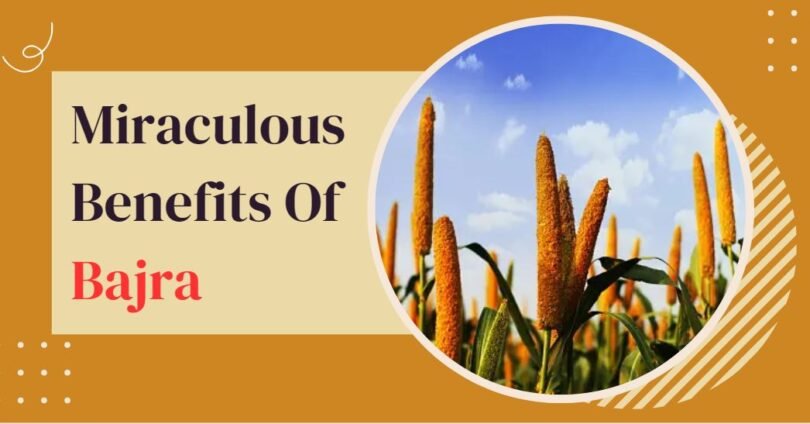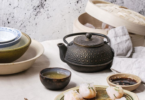There are so many people out there who are allergic to wheat and wheat products. Are you one of them? If so, pearl millet, often referred to as bajra, is the finest substitute for this and has been a mainstay of diets across cultures for ages. It is a nutritious grain. Bajra’s variety in culinary uses adds to its attractiveness and makes it a healthy option for nourishing and wellness. Let’s discuss in this article about the benefits of Bajra and many more about it.
What Is Bajra (Pearl Millet)?
The Pennisetum glaucum plant, usually referred to as pearl millet, is known by the traditional Hindi name bajra. In addition to Bajra in Hindi and Bengali, Sajjalu in Telugu, Kambu in Tamil and Malayalam, Sajje in Kannada, and Bajri in Gujarati, pearl millet is also known by these names. Bajra originated in Africa and was then introduced to India. The crop’s tiny seeds come in a variety of colors, including white, gray, yellow, brown, and bluish-purple. Bajra has a flavor that is in between a somewhat sweet and nutty flavor. Bajra is frequently referred to as the “powerhouse of nutrients” since it is practically bursting at the seams with nutrients that are highly beneficial for the health of the body.
Bajra is cultivated across 260,000 square kilometers of land all over the world, and it accounts for 50% of the millet production related to bajra. The ideal temperature range for this particular crop’s growth is between 25 and 31 degrees Celsius, and it grows in the country’s dry regions. This crop can be cultivated between May and September because it is a kharif crop and can perhaps be grown with other crops like jowar, cotton, and ragi.
Nutrition Facts Of Bajra-
Bajra is highly regarded as the nutrient-dense and easily absorbed cereal grain. It is loaded with carbohydrates, vitamins, minerals, vital amino acids, and antioxidants. The average nutritional breakdown of 1 cup (170 grammes) of cooked millet is as follows:
- Protein: 6 grams
- Calories: 201
- Sodium: 286 mg
- Carbs: 40 grams
- Fiber: 2 grams
- Fat: 1.7 grams
- Magnesium: 18% of the DV
- Folate: 8% of the Daily Value (DV)
- Thiamine: 15% of the DV
- Phosphorus: 14% of the DV
- Niacin: 14% of the DV
- Zinc: 14% of the DV
- Iron: 6% of the DV
- Vitamin B6: 11% of the DV
- Riboflavin: 11% of the DV
What Are The Benefits Of Bajra?
The following are some of the main health advantages of bajra:
Heart Health
For cardiac patients, including bajra in their diet is beneficial because it is a good source of magnesium. Diabetes and high blood pressure are two cardiovascular disease risk factors that magnesium can help to reduce. The high amount of magnesium may support the heart’s healthy operation and regulate heartbeats.
Gluten-free
Bajra is a millet that is completely free of gluten. Bajra might perform wonders for people who are looking for a safer and healthier substitute for wheat. Dishes composed of bajra can keep you strong and healthy because they are packed with protein, fiber, and antioxidants.
Abundant In Antioxidants
Bajra flour has an abundance of antioxidants that could lessen the harm caused by free radicals. It might stop the development of fine lines, wrinkles, and puffiness—early aging symptoms. Also prevent cardiovascular diseases, Alzheimer’s, Parkinson’s. Additionally, it hastens the healing of wounds.
Aids In Weight Loss
As one of the most significant pearl millet Benefits is, including bajra in your diet will help you lose weight. The protein in this millet aids in tissue repair and muscular growth. For vegetarians aiming to limit carbs, it is a viable substitute due to its high protein level.
Improves Digestion
Bajra’s high dietary fiber content promotes healthy digestion and prevents constipation. It is an excellent choice for diabetics as it decreases blood sugar levels as well.
Energy Boost
Complex carbohydrates, such those in bajra, provide you with long-lasting energy. B vitamins, which aid in transforming food into energy, are also abundant in it. This makes it a great option for sustaining your activities all day long.
Improves Bone Health
Bone strength is another significant advantage of consuming bajra. Phosphorus is abundant in bajra, which strengthens bones. Bajra is excellent for arthritis patients because it has antioxidant properties that cure bone inflammation.
What Are The Side Effects Of Bajra?
Bajra has certain unfavorable effects. There are a few things to bear in mind if you want to incorporate this millet into your daily diet. Bajra, or pearl millet, is typically harmless for most people, although having too much might cause digestive discomfort including gas and bloating. People who have a grain allergy need to use caution. Additionally, even though bajra is nutritious, excessive use can result in an intake of too many calories. Diabetics are urged to monitor their blood sugar levels, and those who are on medication should speak with a healthcare professional. To prevent contamination, proper storage is crucial. Before ingesting pearl millet, see your doctor or nutritionist if you have any other health issues.
How To Cook Bajra And Eat Bajra?
After knowing the definition, benefits and side effects of bajra, let’s see how to cook and consume bajra.
Prior to cooking, rinse the bajra. After that take out any debris or dirt that was in the seeds. Now, boil two and a half cups of water or broth for every cup of bajra. Then, incorporate it in boiling water or broth and allow it to return to a boil. 5. Put a cover on it and simmer it for 25 minutes.
It can be used in the same way that regular flour is to make a wide range of items, including cakes, khichdi, bhakris, multigrain chapatis, and wraps. In order to make a khichdi or upma, you can also utilize the entire bajra. Laddu can be made with bajra flour.
Final Words
Bajra is mostly grown in Africa and India, yet it is consumed all around the world. Bajra has a wide range of nutritional advantages, from regulating blood sugar to providing comfort food for celiac patients. It is becoming more and more well-liked because it is healthy and gluten-free. It is affordable, wholesome, flavorful, and seasonal. In order to reap the health benefits of bajra, try incorporating it into your usual menu.






